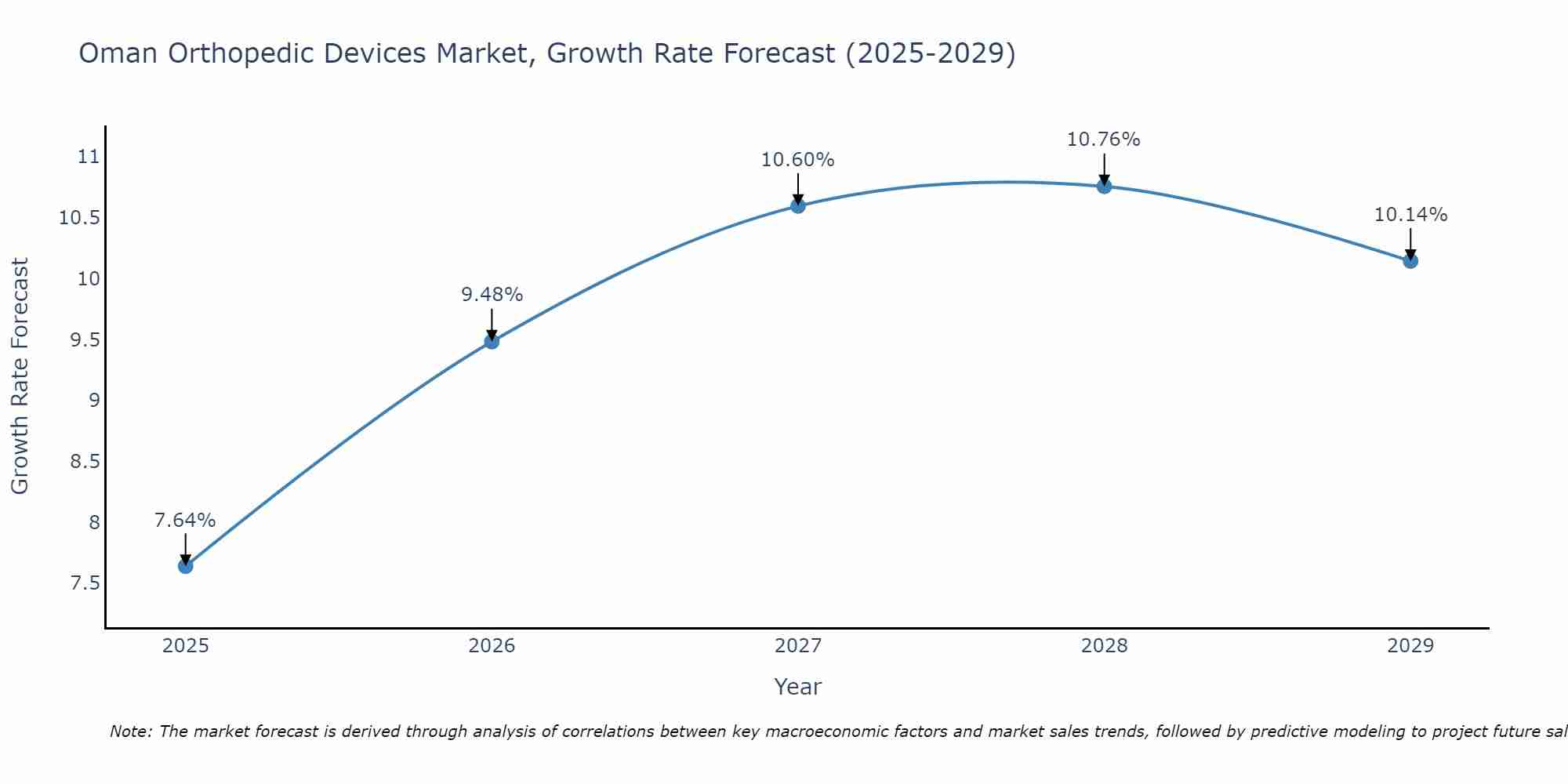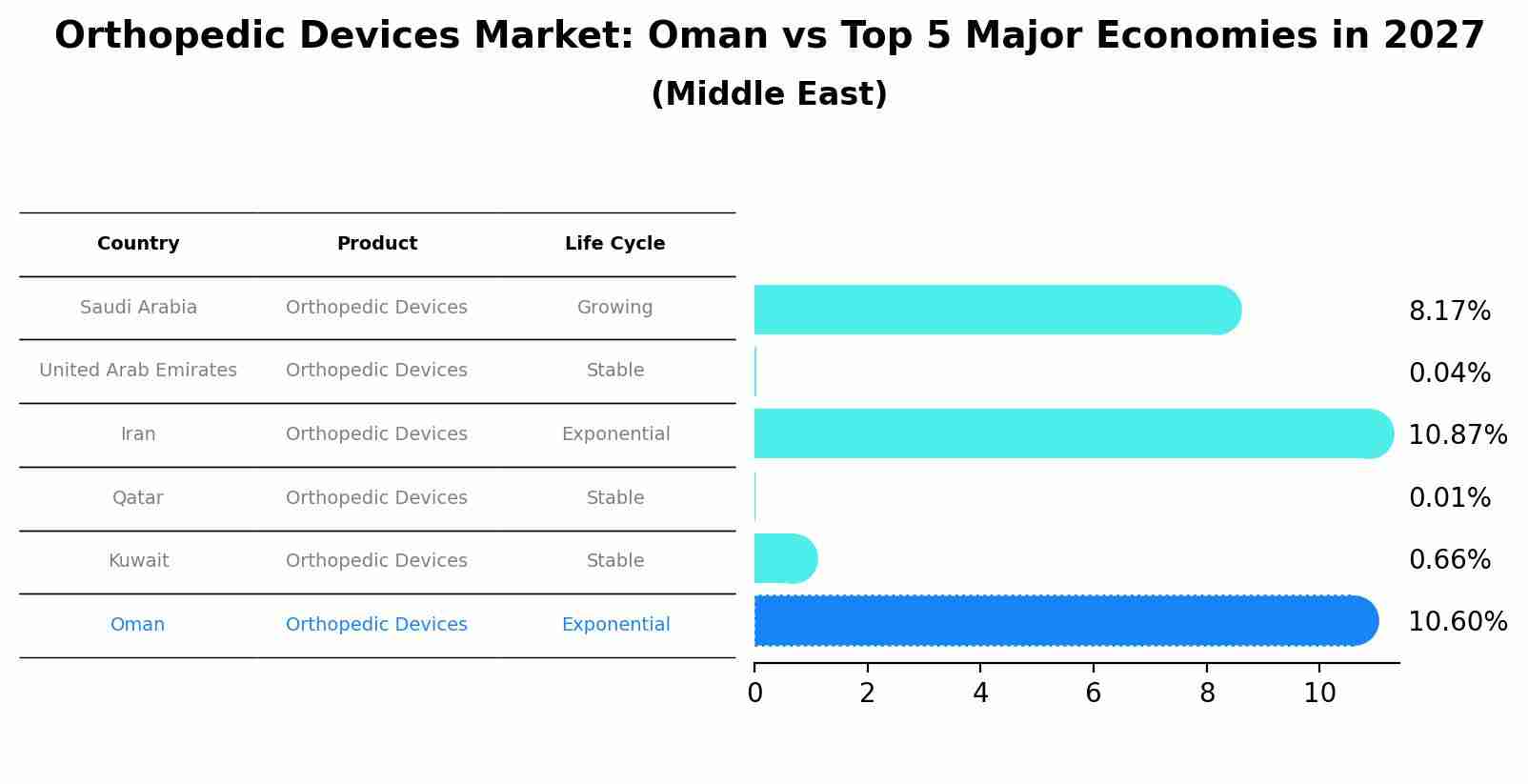Oman Orthopedic Devices Market Outlook | Analysis, Size, COVID-19 IMPACT, Trends, Growth, Forecast, Revenue, Share, Companies, Value & Industry
| Product Code: ETC368143 | Publication Date: Aug 2022 | Updated Date: Jul 2025 | Product Type: Market Research Report | |
| Publisher: 6Wresearch | Author: Sumit Sagar | No. of Pages: 75 | No. of Figures: 35 | No. of Tables: 20 |
Oman Orthopedic Devices Market Size Growth Rate
The Oman Orthopedic Devices Market is projected to witness mixed growth rate patterns during 2025 to 2029. Starting at 7.64% in 2025, the market peaks at 10.76% in 2028, and settles at 10.14% by 2029.

Orthopedic Devices Market: Oman vs Top 5 Major Economies in 2027 (Middle East)
The Orthopedic Devices market in Oman is projected to grow at a high growth rate of 10.60% by 2027, within the Middle East region led by Saudi Arabia, along with other countries like United Arab Emirates, Iran, Qatar and Kuwait, collectively shaping a dynamic and evolving market environment driven by innovation and increasing adoption of emerging technologies.

Oman Orthopedic Devices Market Synopsis
The Oman Orthopedic Devices Market is experiencing steady growth driven by factors such as an aging population, increasing prevalence of orthopedic disorders, and rising awareness about advanced treatment options. The market comprises a wide range of products including joint reconstruction implants, spinal devices, trauma fixation devices, orthobiologics, and orthopedic accessories. Key players in the market are focusing on innovation, product development, and strategic collaborations to gain a competitive edge. Government initiatives to improve healthcare infrastructure and the presence of advanced medical facilities are further propelling market growth. However, pricing pressures, reimbursement challenges, and regulatory hurdles pose potential barriers to market expansion. Overall, the Oman Orthopedic Devices Market is poised for continued growth driven by technological advancements and increasing demand for orthopedic treatments.
Oman Orthopedic Devices Market Trends
The Oman Orthopedic Devices Market is experiencing a shift towards minimally invasive procedures and advanced technology adoption. Key trends include the increasing prevalence of orthopedic disorders due to an aging population, driving demand for joint replacement and orthobiologics products. Innovations in 3D printing technology and materials are enhancing the customization and durability of orthopedic implants. Additionally, the market is witnessing a growing focus on value-based healthcare delivery, leading to the development of cost-effective orthopedic devices and services. Surgeons are increasingly opting for robotic-assisted surgeries for improved precision and better patient outcomes. Overall, the Oman Orthopedic Devices Market is moving towards a patient-centric approach with a strong emphasis on technological advancements and improved clinical outcomes.
Oman Orthopedic Devices Market Challenges
In the Oman Orthopedic Devices Market, some key challenges include limited healthcare infrastructure in remote areas, high cost of orthopedic devices leading to affordability issues for some patients, and lack of skilled orthopedic professionals. Additionally, regulatory hurdles and delays in product approvals can hinder market growth and innovation. The market also faces competition from imported orthopedic devices, which can impact local manufacturers. Moreover, the relatively small market size in Oman compared to larger countries may result in limited opportunities for market expansion and product uptake. Overall, addressing these challenges will require collaboration between industry stakeholders, government entities, and healthcare providers to ensure better access to quality orthopedic devices and services for the population in Oman.
Oman Orthopedic Devices Market Investment Opportunities
Investment opportunities in the Oman Orthopedic Devices Market include the growing demand for advanced orthopedic devices due to an aging population and an increase in chronic diseases such as osteoarthritis and osteoporosis. There is a need for innovative orthopedic solutions to address these health issues, presenting opportunities for companies to introduce cutting-edge technologies and products in the market. Additionally, the government`s focus on expanding healthcare infrastructure and improving access to quality healthcare services further enhances the potential for investment in the orthopedic devices sector in Oman. Investing in research and development, strategic partnerships with local healthcare providers, and market expansion initiatives can help companies capitalize on the growing demand for orthopedic devices in Oman.
Jordan Agar Market Government Policies
Government policies play a significant role in regulating the Oman Orthopedic Devices Market. The Ministry of Health in Oman oversees the registration, importation, and distribution of medical devices, including orthopedic devices. The government has implemented regulations to ensure the quality, safety, and efficacy of orthopedic devices in the market, with strict requirements for registration and approval. Additionally, there are guidelines in place to control pricing and reimbursement schemes for orthopedic devices, aiming to make them more accessible to patients. The government also encourages local manufacturing of medical devices through incentives and support programs. Overall, the government policies in Oman aim to foster a competitive and compliant orthopedic devices market while promoting innovation and quality standards.
Oman Orthopedic Devices Market Future Outlook
The future outlook for the Oman Orthopedic Devices Market appears positive, driven by factors such as an aging population, increasing prevalence of orthopedic disorders, and technological advancements in medical devices. The market is expected to witness steady growth as the demand for orthopedic implants, prosthetics, and instruments continues to rise. Additionally, the government`s focus on improving healthcare infrastructure and increasing healthcare expenditure are likely to contribute to market expansion. However, challenges such as limited access to specialized orthopedic care in remote areas and pricing pressure may hinder the market growth to some extent. Overall, with ongoing advancements in orthopedic technologies and a growing patient population requiring orthopedic interventions, the Oman Orthopedic Devices Market is poised for a promising future.
Key Highlights of the Report:
- Oman Orthopedic Devices Market Outlook
- Market Size of Oman Orthopedic Devices Market, 2021
- Forecast of Oman Orthopedic Devices Market, 2031
- Historical Data and Forecast of Oman Orthopedic Devices Revenues & Volume for the Period 2018 - 2031
- Oman Orthopedic Devices Market Trend Evolution
- Oman Orthopedic Devices Market Drivers and Challenges
- Oman Orthopedic Devices Price Trends
- Oman Orthopedic Devices Porter's Five Forces
- Oman Orthopedic Devices Industry Life Cycle
- Historical Data and Forecast of Oman Orthopedic Devices Market Revenues & Volume By Application for the Period 2018 - 2031
- Historical Data and Forecast of Oman Orthopedic Devices Market Revenues & Volume By Hip Orthopedic Devices for the Period 2018 - 2031
- Historical Data and Forecast of Oman Orthopedic Devices Market Revenues & Volume By Knee Orthopedic Devices for the Period 2018 - 2031
- Historical Data and Forecast of Oman Orthopedic Devices Market Revenues & Volume By Spine Orthopedic Devices for the Period 2018 - 2031
- Historical Data and Forecast of Oman Orthopedic Devices Market Revenues & Volume By Craniomaxillofacial Orthopedic Devices for the Period 2018 - 2031
- Historical Data and Forecast of Oman Orthopedic Devices Market Revenues & Volume By Dental Orthopedic Devices for the Period 2018 - 2031
- Historical Data and Forecast of Oman Orthopedic Devices Market Revenues & Volume By Sports Injuries, Extremities And Trauma (Set) Orthopedic Devices for the Period 2018 - 2031
- Historical Data and Forecast of Oman Orthopedic Devices Market Revenues & Volume By Product for the Period 2018 - 2031
- Historical Data and Forecast of Oman Orthopedic Devices Market Revenues & Volume By Drill Guide for the Period 2018 - 2031
- Historical Data and Forecast of Oman Orthopedic Devices Market Revenues & Volume By Guide Tubes for the Period 2018 - 2031
- Historical Data and Forecast of Oman Orthopedic Devices Market Revenues & Volume By Implant Holder for the Period 2018 - 2031
- Historical Data and Forecast of Oman Orthopedic Devices Market Revenues & Volume By Custom Clamps for the Period 2018 - 2031
- Historical Data and Forecast of Oman Orthopedic Devices Market Revenues & Volume By Distracters for the Period 2018 - 2031
- Historical Data and Forecast of Oman Orthopedic Devices Market Revenues & Volume By Screw Drivers for the Period 2018 - 2031
- Historical Data and Forecast of Oman Orthopedic Devices Market Revenues & Volume By Accessories for the Period 2018 - 2031
- Oman Orthopedic Devices Import Export Trade Statistics
- Market Opportunity Assessment By Application
- Market Opportunity Assessment By Product
- Oman Orthopedic Devices Top Companies Market Share
- Oman Orthopedic Devices Competitive Benchmarking By Technical and Operational Parameters
- Oman Orthopedic Devices Company Profiles
- Oman Orthopedic Devices Key Strategic Recommendations
Frequently Asked Questions About the Market Study (FAQs):
- Single User License$ 1,995
- Department License$ 2,400
- Site License$ 3,120
- Global License$ 3,795
Search
Related Reports
- Vietnam System Integrator Market (2025-2031) | Size, Companies, Analysis, Industry, Value, Forecast, Growth, Trends, Revenue & Share
- ASEAN and Thailand Brain Health Supplements Market (2025-2031) | Strategy, Consumer Insights, Analysis, Investment Trends, Opportunities, Growth, Size, Share, Industry, Revenue, Segments, Value, Segmentation, Supply, Forecast, Restraints, Outlook, Competition, Drivers, Trends, Demand, Pricing Analysis, Competitive, Strategic Insights, Companies, Challenges
- ASEAN Bearings Market (2025-2031) | Strategy, Consumer Insights, Analysis, Investment Trends, Opportunities, Growth, Size, Share, Industry, Revenue, Segments, Value, Segmentation, Supply, Forecast, Restraints, Outlook, Competition, Drivers, Trends, Demand, Pricing Analysis, Competitive, Strategic Insights, Companies, Challenges
- Europe Flooring Market (2025-2031) | Outlook, Share, Industry, Trends, Forecast, Companies, Revenue, Size, Analysis, Growth & Value
- Saudi Arabia Manlift Market (2025-2031) | Outlook, Size, Growth, Trends, Companies, Industry, Revenue, Value, Share, Forecast & Analysis
- Uganda Excavator, Crane, and Wheel Loaders Market (2025-2031) | Strategy, Consumer Insights, Analysis, Investment Trends, Opportunities, Growth, Size, Share, Industry, Revenue, Segments, Value, Segmentation, Supply, Forecast, Restraints, Outlook, Competition, Drivers, Trends, Demand, Pricing Analysis, Competitive, Strategic Insights, Companies, Challenges
- Rwanda Excavator, Crane, and Wheel Loaders Market (2025-2031) | Strategy, Consumer Insights, Analysis, Investment Trends, Opportunities, Growth, Size, Share, Industry, Revenue, Segments, Value, Segmentation, Supply, Forecast, Restraints, Outlook, Competition, Drivers, Trends, Demand, Pricing Analysis, Competitive, Strategic Insights, Companies, Challenges
- Kenya Excavator, Crane, and Wheel Loaders Market (2025-2031) | Strategy, Consumer Insights, Analysis, Investment Trends, Opportunities, Growth, Size, Share, Industry, Revenue, Segments, Value, Segmentation, Supply, Forecast, Restraints, Outlook, Competition, Drivers, Trends, Demand, Pricing Analysis, Competitive, Strategic Insights, Companies, Challenges
- Angola Excavator, Crane, and Wheel Loaders Market (2025-2031) | Strategy, Consumer Insights, Analysis, Investment Trends, Opportunities, Growth, Size, Share, Industry, Revenue, Segments, Value, Segmentation, Supply, Forecast, Restraints, Outlook, Competition, Drivers, Trends, Demand, Pricing Analysis, Competitive, Strategic Insights, Companies, Challenges
- Israel Intelligent Transport System Market (2025-2031) | Strategy, Consumer Insights, Analysis, Investment Trends, Opportunities, Growth, Size, Share, Industry, Revenue, Segments, Value, Segmentation, Supply, Forecast, Restraints, Outlook, Competition, Drivers, Trends, Demand, Pricing Analysis, Competitive, Strategic Insights, Companies, Challenges
Industry Events and Analyst Meet
Our Clients
Whitepaper
- Middle East & Africa Commercial Security Market Click here to view more.
- Middle East & Africa Fire Safety Systems & Equipment Market Click here to view more.
- GCC Drone Market Click here to view more.
- Middle East Lighting Fixture Market Click here to view more.
- GCC Physical & Perimeter Security Market Click here to view more.
6WResearch In News
- Doha a strategic location for EV manufacturing hub: IPA Qatar
- Demand for luxury TVs surging in the GCC, says Samsung
- Empowering Growth: The Thriving Journey of Bangladesh’s Cable Industry
- Demand for luxury TVs surging in the GCC, says Samsung
- Video call with a traditional healer? Once unthinkable, it’s now common in South Africa
- Intelligent Buildings To Smooth GCC’s Path To Net Zero













